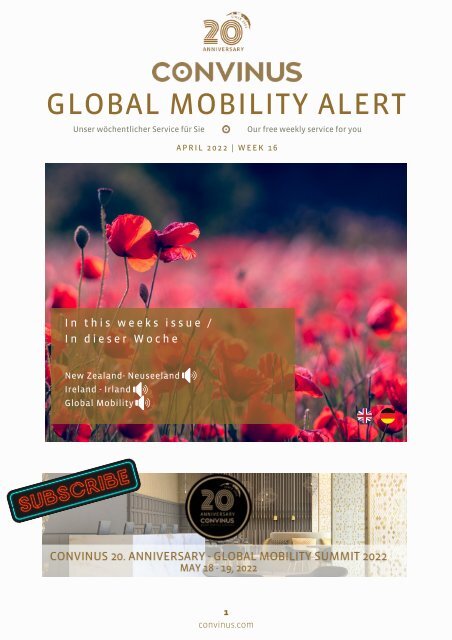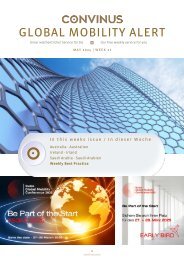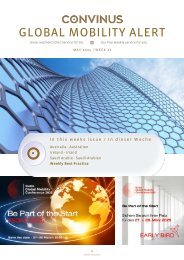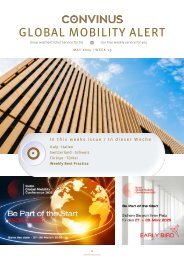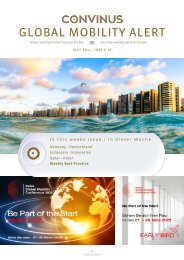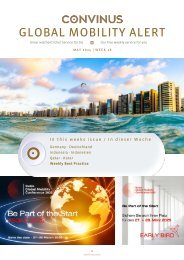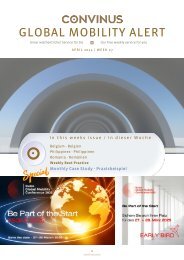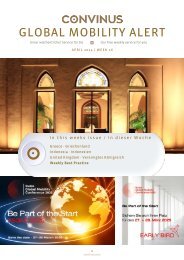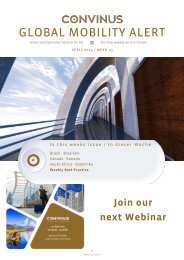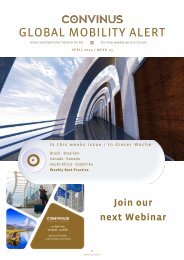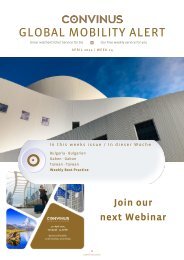CONVINUS Global Mobility Alert Week 17.2022
Create successful ePaper yourself
Turn your PDF publications into a flip-book with our unique Google optimized e-Paper software.
GLOBAL MOBILITY ALERT<br />
Unser wöchentlicher Service für Sie Our free weekly service for you<br />
A P R I L 2 0 2 2 | W E E K 1 6<br />
I n t h i s w e e k s i s s u e /<br />
I n d i e s e r W o c h e<br />
New Zealand- Neuseeland<br />
Ireland - Irland<br />
<strong>Global</strong> <strong>Mobility</strong><br />
1<br />
convinus.com
Haben Sie schon<br />
Ihre Vorsätze für<br />
das neue Jahr<br />
getroffen?<br />
2022<br />
investieren Sie<br />
in Ihre Karriere<br />
Ihr <strong>Global</strong> <strong>Mobility</strong><br />
Karriere-Booster!<br />
Mit unseren<br />
Webinaren inkl.<br />
Zertifikat über Ihre<br />
neu erworbenen Skills<br />
Alle Details:<br />
shop.convinus.com
New Zealand / April 28, 2022<br />
New Work Visa Program for Accredited Employers<br />
The New Zealand Immigration Service is introducing the long-awaited Work Visa Program for Accredited Employers<br />
as of July 4, 2022. The program includes the introduction of the following three checks that an employer must pass<br />
to be able to hire a migrant worker:<br />
The Employer Check verifies whether the employer is already accredited under the new system. If this is not the<br />
case, the employer must apply for an accreditation to be able to hire migrants. Once the application has been<br />
approved, the employer will receive an accreditation for 12 months, before having to renew it.<br />
The Job Check examines whether the salary level is in line with the market, the working conditions comply with<br />
the labor laws, and if necessary, whether a labor market test has been done. After this check, the migrant can<br />
be hired.<br />
The Migrant Worker Check is the last step in the new system where the new visa application from the migrant is<br />
checked. The migrant must show that she/he meets the New Zealand Immigration requirements and has the<br />
necessary skills to perform the job.<br />
The three checks will be introduced into the new program in stages, starting with the Employer Check. Employers<br />
who are not yet accredited can submit their applications for accreditation as of May 23, 2022. Employers who are<br />
already accredited can start the Job Check as of June 20, 2022. Applications for the Migrant Worker Check will then<br />
be accepted by New Zealand Immigration Services as of July 4, 2022, if the previous two checks have been<br />
completed.<br />
Neuseeland / 28. April 2022<br />
Neues Arbeitsvisum-Programm für akkreditierte<br />
Arbeitgeber<br />
Die neuseeländische Einwanderungsbehörde führt per 4. Juli 2022 das lang erwartende Arbeitsvisum-Programm für<br />
akkreditierte Arbeitgeber («Work Visa Program for Accredited Employers») ein. Das Programm umfasst die<br />
Einführung der folgenden drei Prüfungen, die ein Arbeitgeber bestehen muss, um einen Arbeitsmigranten<br />
einstellen zu dürfen:<br />
Beim «Employer Check» wird überprüft, ob der Arbeitgeber bereits nach dem neuen System akkreditiert ist. Ist<br />
dies nicht der Fall, muss der Arbeitgeber eine Akkreditierung beantragen, um Migranten einstellen zu dürfen.<br />
Sobald der Antrag genehmigt wurde, erhält der Arbeitgeber eine Zulassung für 12 Monate, bevor er sie erneuern<br />
muss.<br />
Beim «Job Check» wird geprüft, ob das Gehaltsniveau marktgerecht ist, die Arbeitsbedingungen den<br />
arbeitsrechtlichen Vorschriften entsprechen und ob gegebenenfalls eine Arbeitsmarktprüfung durchgeführt<br />
wurde. Nach dieser Prüfung kann der Migrant eingestellt werden.<br />
Der «Migrant Worker Check» ist der letzte Schritt in dem neuen System, bei dem der neue Visumantrag des<br />
Migranten geprüft wird. Der Migrant muss nachweisen, dass er die Anforderungen der neuseeländischen<br />
Einwanderungsbehörde erfüllt und über die erforderlichen Fähigkeiten für die Ausübung der Tätigkeit verfügt.<br />
Die drei Checks werden etappenweise in das neue Programm eingeführt, beginnend mit dem «Employer Check».<br />
Arbeitgeber, welche noch nicht akkreditiert sind, können ihre Anträge auf Akkreditierung ab dem 23. Mai 2022<br />
einreichen. Arbeitgeber, welche bereits akkreditiert sind, können ab dem 20. Juni 2022 mit dem «Job Check»<br />
beginnen. Anträge für den «Migrant Worker Check» werden dann per 4. Juli 2022 von den neuseeländischen<br />
Einwanderungsbehörden entgegengenommen, insofern die vorherigen zwei Checks abgeschlossen wurden.<br />
3<br />
convinus.com
Ireland / April 28, 2022<br />
New five-year multiple entry visa<br />
The Minister of Justice of Ireland announced the introduction of a five-year multiple entry visa for all travelers to<br />
Ireland. Until now, the longest duration of a visa was only 3 years. This is a relief for all Business Travelers as well<br />
as foreign workers who will then pursue gainful employment in Ireland.<br />
A work permit prior to commencement of employment will still be required for third country nationals.<br />
Irland / 28. April 2022<br />
Neus fünfjähriges Mehrfacheinreisevisum<br />
Die Justizministerin Irlands kündigte die Einführung eines fünfjährigen Mehrfacheinreisevisums für alle Reisenden<br />
nach Irland an. Bis anhin betrug die längste Dauer eines Visums für Irland nur 3 Jahre. Das ist eine Erleichterung für<br />
Geschäftsreisende sowie ausländische Arbeitnehmer, die in Irland einer Erwerbstätigkeit nachgehen werden.<br />
Für Drittstaatsangehörige ist eine Arbeitsbewilligung vor Aufnahme der Tätigkeit weiterhin erforderlich.<br />
4<br />
convinus.com
April 28, 2022<br />
How old is your assignment policy actually? - If you are one of the few companies that have revised their policy in the last 2<br />
years, i.e. during and after the pandemic, you can safely stop reading at this point. For everyone else, the following text may<br />
prove helpful.<br />
<strong>Global</strong> <strong>Mobility</strong>:<br />
New Forms of International Assignments Require<br />
New Assignment Policies<br />
In a survey conducted by EY, 86% of the respondents said that the family no longer wants to accompany the employee during the<br />
international assignment. Is this drastic culture change already reflected in your policy? Or rather not? If so, you are in good<br />
company. In our daily practice, we see numerous companies that keep their outdated policies under lock and key, or that have<br />
assignment policies that go into great detail about covering foreign school costs, but do not address weekly trips home for the<br />
internationally assigned employee.<br />
More than half of the respondents also assume that the number of short- and long-term assignments will be (further) reduced<br />
and that virtual assignments, extended business trips and "hybrid" assignment solutions will take their place. Hybrid solutions<br />
are understood to be regular assignments abroad while spending the rest of the week/ month in the home country. We also see<br />
this trend in our consulting practice. Currently, these cases are often solved in individual decisions. Of course, because these<br />
cases are rather unique.<br />
Nevertheless, it is now time to not only evaluate the benefits in the already existing assignment policy, but to fundamentally<br />
question whether the guidelines still reflect the current practice of foreign assignments in your company. A first step here would<br />
be to find out which employees actually work abroad on a regular basis. A second step would be to check whether these foreign<br />
assignments still fit into the existing policy patterns, or whether fundamentally new structures have to be created for this<br />
purpose.<br />
This is not magic. With a structured approach, you as a global mobility and HR manager could soon brag that you not only have a<br />
great policy, but more importantly, one that fits your employees' international assignments.<br />
5<br />
convinus.com
28. April 2022<br />
<strong>Global</strong> <strong>Mobility</strong>:<br />
Neue Formen von Auslandseinsätzen erfordern<br />
neue Entsenderichtlinien<br />
Wie alt ist eigentlich Ihre Entsendungspolicy? – Wenn Sie zu den wenigen Unternehmen gehören, die in den letzten 2 Jahren, das<br />
heisst, während und nach der Pandemie, Ihre Policy überarbeitet haben, können Sie an dieser Stelle getrost aufhören zu lesen.<br />
Für alle anderen könnte sich der nachfolgende Text als hilfreich erweisen.<br />
In einer Umfrage von EY gaben 86% der befragen Teilnehmer an, dass die Familie den Mitarbeiter nicht mehr während des<br />
Auslandseinsatzes begleiten möchte. Wird dieser drastische Kulturwandel bereits in Ihrer Policy reflektiert? Oder eher nicht?<br />
Dann sind Sie in guter Gesellschaft. In unserer täglichen Praxis sehen wir zahlreiche Unternehmen, die ihre veraltete Policy unter<br />
Verschluss halten oder aber Entsenderichtlinien, die sich zwar äusserst detailliert zur Übernahme ausländischer Schulkosten<br />
äussern, aber wöchentliche Heimreisen für den Entsandten nicht geregelt haben.<br />
Mehr als die Hälfte der Befragten geht zudem davon aus, dass sich die Anzahl von Kurz- und Langzeitentsendungen (weiter)<br />
reduzieren wird und an diese Stelle virtuelle Entsendungen, ausgedehnte Geschäftsreisen und «hybride» Einsatzlösungen treten<br />
werden. Als hybride Lösungen, werden dabei regelmässige, tageweise Auslandseinsätze verstanden. Diesen Trend sehen wir auch<br />
klar in unserer Beratungspraxis. Gegenwärtig werden diese Fälle oftmals in Einzelfallentscheidungen gelöst. Klar. Denn diese<br />
Fälle sind auch meistens einzigartig.<br />
Dennoch ist es nun an der Zeit, nicht nur die Benefits in der bereits vorhandenen Entsendungspolicy zu evaluieren, sondern<br />
grundsätzlich zu hinterfragen, ob die Richtlinien noch die heutige Praxis von Auslandseinsätzen in Ihrem Unternehmen<br />
widerspiegeln. Ein erster Schritt wäre es, hier in Erfahrung zu bringen, welche Mitarbeiter überhaupt (regelmässig) im Ausland<br />
arbeiten. Ein zweiter Schritt wäre es dann, abzugleichen, ob diese Auslandseinsätze noch in die bestehenden Policymuster<br />
passen oder ob hierfür grundlegend neue Strukturen geschaffen werden müssen.<br />
Dies ist kein Hexenwerk. Mit einer strukturierten Vorgehensweise könnten Sie sich als <strong>Global</strong> <strong>Mobility</strong> und HR-Verantwortlich<br />
bald rühmen, nicht nur eine großartige Policy zu haben, sondern vor allem eine, die zu den Auslandseinsätzen Ihrer Mitarbeiter<br />
passt.<br />
6<br />
convinus.com


